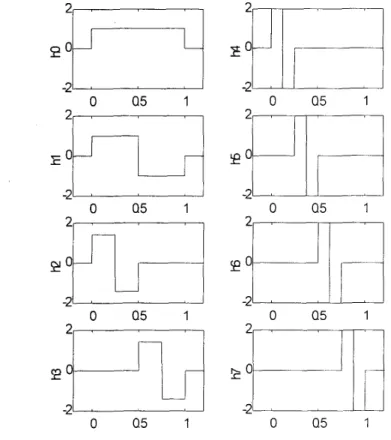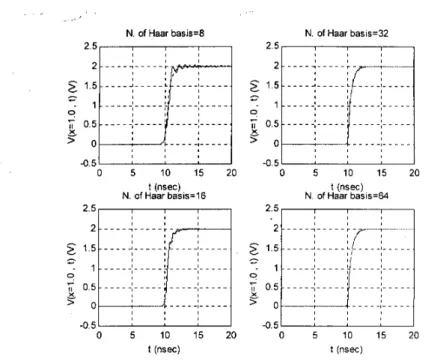A Haar Wavelet Approach for Solving the Transient
Response of Inhomogeneous Transmission Lines
I.T. Chiang* and S.K. Jeng
Graduate Institute of Communication Engineering and Department of Electrical Engineering
National Taiwan University Taipei , Taiwan, ROC.
Email:skjeng@ew.ee.ntu.edu. tw
Abstract
Wavelets have been used as tools to solve problems in signal analysis, image analysis, medical diagnostics, and many others. This paper will use the Maar wavelets to solve transient problems in transmission lines, both homogeneous and inhomogeneous. The feature of this newly-developed approach is that it converts the original partial differential equations, the telegraphist’s equations or the transmission-line equations, to a system of ordinary differential equations via Haar wavelets, which can be solved numerically. Examples of non-sinusoidal excitations, such as the unit step function and the rectangular pulse function for digital transmission in particular. are included to demonstrate the usefulness of this analysis tool.
I
IntroductionIn this paper, we’d like to solve the transient wave propagation i n transmission lines. One possible approach is to analyze and solve the problem in frequency domain and then take the inverse Fourier transform. The drawback of this approach is that signals with finite durations in time domain, such as the rectangular pulse. have to be truncated in frequency domain, which introduces much error. Another approach is the FDTD method. However, if we need only the response at a specific position, the FDTD seems to be inefficient since the FDTD has to do calculation of all time-space points. The difficulties of the above approaches can be reduced signilicnntly by our new method. We’ll describe it in the following and give some numerical examples.
lI
FormulationThe well-known telegraphist’s equations are 0-7803-6369-8/00/$10.00 82000 IEEE 2183
Haar wavelets, generated by dilations and translations just like other kinds of wavelets, are applied to expand the voltage and current functions in time domain. Then, E q . ( l )
becomes a system of ordinary differential equations which can be expressed as
d 1
dx Af
-
-[VI
= [ M I - ' ( [RI+
-[L])[
i] ( 2 a )d 1
dx Af
- -[ I'] =
[MI-'([
GI+-[Cl)[ v ] ( 2 6 )where [ v J and [ i ] are column matrices whose elements are the expansion coefficients of the wavelets,
[RI,
[L
1,
[ G I , [ C ] and [ M I are square matrices, andAt is the normalization time interval. The Haar wavelets are orthogonal and defined originally in the interval 0
<
f < 1 . The first eight Haar functions are shown in Fig. 1. In general,$ ( f ) = l , h,(t)=2Xh, ( 2 ' f -%,)
n = 2 ' + k , j = 0 , 1 , 2 ; . . , 0 < k < 2 '
Here 2% is used to make the bases orthonormal. To be convenient, we deal with
lossless lines(R=G=O) only here. Moreover, when lines are homogeneous, i.e. [
L ]
and [ C ] are constants, we can use the analytic method in [l], accompanying with the match of impedance boundary conditions, to get our solutions. For inhomogeneous lines such as tapered lines, where
[ L ]
and [ C ] are function of position, a simple finite difference method is used instead[2].m
Numerical ResultsIn Fig.2 and Fig.3, we set A f = l(nsec) and calculate from 0 to 20Ar. So the total number of basis must be the multiplication of 20 and the number used in each A f
time interval. In Fig. 2, we handle a lossless and homogeneous transmission line with wave velocity U, = 10* ( m / s ) , characteristic impedance
Z,,
= 50(n)
, length / = 1 (m), a matched-generator which generates a unit step excitation and a capacitive load C , ~ = l o ( @ ) . The solid line is obtained by our approach and the dashed line is the analytic solution. It is shown that the more'number of bases we use, the more accurate and smooth the result is. Fig.3 exhibits the inhomogeneous case, which is a linearly t a p e r e d l i n e w i t h L ( x ) = 5 x lO-'(H/m)and C ( x ) = 2 x IO-"'/(l +2x)*(F/m). The load used here isC,.
= 20O(pF) and the excitation voltage is a rectangular pulse with width w = l(17sec). Eight bases in each time interval and the finite differencemethod with step sizes h = 0.1 (solid line) and h = 0.05 (dashed line) are applied respectively. Both results are consistent.
fl
References[ I ] C. F. Chen and C. H. Hsiao, “Haar wavelet method for solving Inmped and distributed-parameter systems”, IEE Proc. -Control Theory Appl. Vol. 144,
no 1, January 1997.
[2] R. Burden and J. Faires, “Numerical Analysis, 5“’ ed.”, PWS. Boston. 1993.
-
2
1
o
a5
1
-
0a5
12,
1 1 -2-o
a5 1-2
-0Q5
1 0Q5
1‘“;_I
-2
0a5
1 0 Q5 1Fig. 1 First eight Haar functions 2185
0 5 10 15 20 t (nsec) N. of Haar basis=32 2.5 I I I t (nsec) N of Haar basis=64 0 - 0 5 0 5 10 15 20 t (nsec)
Fig. 2 Step response of homogeneous line using analytic(das1ied) and our Haar wavelet approach(so1id) 0.18 0.16 0 14 0 12
-
L 0 1-
-
0 0 08p
0 0 6 0 04 0 02-
,I 0 -0.02 0 2 4 6 8 10 12 14 16 18 20 t ( n s e c )Fig. 3 Pulse response of a linear tapered line using our Haar wavelet approach 2186

